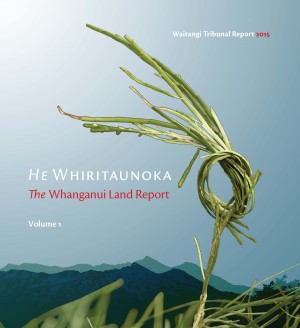Whanganui Land Report released

The Waitangi Tribunal today released He Whiritaunoka: The Whanganui Land Report, in which it reports to the Crown on 83 claims of hapū and iwi of the Whanganui inquiry district. Finding that the claims were largely well founded, the Tribunal concludes that, since 1840, the Crown has caused Māori in Whanganui substantial harm through a multitude of policies, laws, decisions, acts, and omissions.
The report, which focuses on the relationship between the tangata whenua of Whanganui and their land, follows on from the Tribunal’s Whanganui River Report of 1999, on which the Crown and claimants reached a settlement last year.
In her letter accompanying the report, presiding officer Judge Carrie Wainwright said: ‘it should not come as a surprise that the process of colonisation in Whanganui did not evolve in a way that was consistent with the Treaty of Waitangi, and especially the guarantee of te tino rangatiratanga in the Māori text. But the Crown also fell short of the standards of justice and fair dealing that flowed from the Magna Carta, and which British officials acknowledged independently of the Treaty.’
The Tribunal finds that a prime example was the long-drawn-out purchase during the 1840s of the Whanganui block. The Crown surreptitiously acquired twice as much land as it purported to be acquiring but it did not increase the price and it limited the number of reserves to be set aside for ongoing Māori use. In later purchases, the Crown was less blatantly deceptive, but nevertheless the purchase of the Waimarino block – one of the largest North Island acquisitions in the nineteenth century – was a truly shoddy affair: hurried, penny-pinching, and involving the illegal purchase of children’s interests.
By 1900, the Tribunal finds, Māori in Whanganui retained only a third of their land. Ignoring the warnings of the Stout–Ngata commission against further purchases, the Crown steamed ahead with its own land purchases and also allowed extensive private purchasing. Today, just 237,000 acres (about 11 per cent of the district) remain in Māori ownership.
The Tribunal urges the Government to enter into a settlement that supports the aspirations of the hapū and iwi of Whanganui for economic and cultural revitalisation. This in turn would have the effect of stimulating economic growth in the Whanganui region.
The Tribunal likewise encourages the Crown to give Whanganui Māori greater involvement in local government and more control over matters that affect them, and to work with claimants and local authorities to solve the numerous longstanding problems detailed in its report. Of these local issues, public works takings of Māori land were among the most-resented acts of central and local authorities.
One of the report’s key findings is that the Crown acquired the land that makes up the Whanganui National Park unjustly and in breach of Treaty principles. The Tribunal recommends the return to tangata whenua of title to land in the park and a substantial management role for them.
The Tribunal also makes recommendations in relation to the spelling of te reo Māori place names. As regards Whanganui, it concludes that tangata whenua should control their own language, and specifically the spelling of names in their rohe (tribal area). The Tribunal recommends that the Crown overturn a recent decision that authorised both ‘Wanganui’ and ‘Whanganui’ as legitimate spellings. In the claimants’ view it is ‘Whanganui’, and the Crown should respect their preference.
He Whiritaunoka: The Whanganui Land Report [PDF, 827 KB] [PDF, 827 KB]
Purchase Tribunal Reports from Legislation Direct(external link)
Email: Ldorders@legislationdirect.co.nz
Phone: 04 568 0005
For media inquiries, contact the Ministry of Justice media centre(external link)